In 1789 the new ideals of the French Revolution – freedom, equality and fraternity – provoked a change of style replacing pompous luxury with simpler and uncluttered aesthetics. The Escarpin is a delicately crafted boot, built on a flat sole, the upper made from leather or fabric reaching above the ankle and closing on the side held by woven straps. For the first time, the Escarpin represented a fashion item worn by all folk regardless of their social status, sported across the entire Alpine Region and beyond.
Our boots are designed as a hybrid between a 18th century Escarpin and a 1970s Mohamed Ali boxing boot.
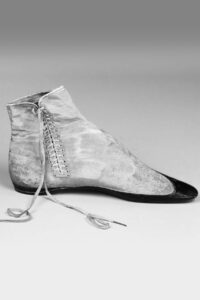
1850s Escarpin boots/ Victoria & Albert Museum/ London

Mohamed Ali boxing boot 1968

Women wearing Escarpin boots, Philibert Louis Debucourt, Vent derrière, 1812, The Clark Art Institute, USA
The BARABARA Escarpin
At BARABARA we love this optimistic and ‘border crossing’ concept and have developed a contemporary and non seasonal ankle boot for women of all ages and backgrounds. The BARABARA Escarpin is an alternative suggestion to the classic trainer or sneaker, which we all wear so excessively every day. The trainer is always comfortable to wear and an effortless choice to make – but we are tired of it!
With the signature BARABARA Escarpin, you will enjoy all the benefits of a classic sport shoe, but with a graceful looking and considered design.
Our shoes are made in the Marche region of Italy, by a small family business run by two sisters. The company has been making shoes for 30 years and manufactures small batches of unique shoes made of finest quality materials with rare levels of craftsmanship and care. Please find all details of our sustainable materials used on the associated product page.
A pot holder is traditionally a square of hand crochet piece of cloth that is designed to enable you to touch hot pot handles, and casserole dishes when cooking.
In the 20th century, the making of pot holders was often the first handicraft lesson in an elementary school for girls. Traditionally pot holders were made by daughters as a popular Mother's Day gift.
At BARABARA we choose this domestic hand crochet item, because for us it stands for the love and labour of generations of women who applied their joy of making and use of vibrant colour to a useful domestic tool, which is almost forgotten today. But these ladies, who went to school in the 1950s and 60s, are today's keepers of traditional crafts such crochet, knitting and embroidery. We want to pay homage to these women, who are our mothers, grandmothers or great-grandmothers today.
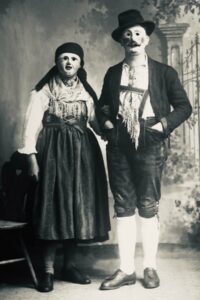
Perchtenlaufen is a folk custom found in the Isartal/ Bavaria region of central Europe. Occurring on set occasions, the ceremony involves two groups of locals fighting against one another using wooden canes and sticks. Both groups are masked, one as 'beautiful' and the other as 'ugly' Perchte. The Dirndl costume‘s corset top is the reference for our knitted pot holder vest.
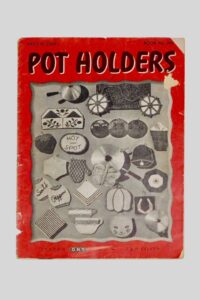
Pot Holders Magazine (1943)
The BARABARA Pot holder Hat and Vest
The hats are constructed following the shape of a helmet, keeping your ears cosy and warm and the vests are a simplified knitted take on a traditional Bavarian Dirndl top.
Our knitwear is produced by MyOma.de, a social enterprise set up to support the older generation who are skilled at knitting and crochet, creating friendships and a source of income through a shared love of craft. Demographics show that there will be more and more older people in Germany in the future, who will need social and financial support. At BARABARA we believe that our business can make an important contribution to a sustainable integration of funds and social needs. Some of our knitters like to meet regularly to chat, others just like to knit as a creative outlet, and to earn some money with their hobby.
Such projects can only survive in the long term if our community understands the true cost – and value – of “social” products. This is why we are transparent in our pricing structure.
We are using 100 % Merino wool extrafine, mulesing free, sourced in Australia and made in Italy.
We are aiming to source recycled and local wool manufactures for the coming seasons.
At the end of World War II in 1945, Germany was split into four administrative sectors by the allied forces of France, Great Britain, Soviet Union and the United States. The state of Bavaria turned into the American occupation zone, where young US soldiers looked after the reconstruction of a new political and administrative system through the process of demilitarisation, denazification, democratization and decentralisation.
An influx of American culture and art brought about by these soldiers captivated the imagination of young Germans who were longing for a liberal and democratic way of life. American youth culture, music, film, fashion and art became sign posts for a better future promising political renewal, freedom and self expression.
Under these influences Bavaria became the cradle of new German Cinema of the 1960s and 70s.
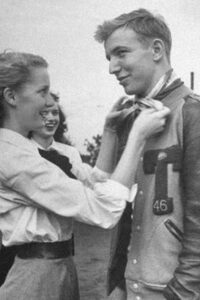
In the 1950s and 60s every high school girl wanted to wear her boyfriend's varsity jacket.

1950s "The Dragetts and Skinners", Life Magazine, Photographer Francis Miller
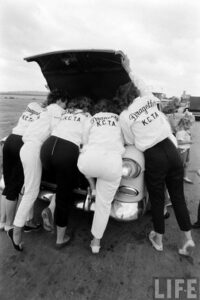
The BARABARA Varsity Jacket
We selected the American Varsity jacket, which appeared in films by Wim Wenders, Werner Herzog and Rainer Werner Fassbinder. Becoming a global symbol for youth, camaraderie and cooperation, we are using this iconic garment as a canvas to appliqué traditional Alpine motifs as an expression of audacious optimism.
We produce this hand made jacket in our studio in Munich, made to order in limited numbers. The jackets feature embroidery, appliqué, crochet, and require complex assembly. We prefer to keep the production all in one place to keep carbon footprint and additional shipping costs to a minimum.
The Charivari served as jewelry or as a talisman for a successful hunt and was a valuable status symbol for farmers and their wives. Since the late 18th century they were given as a gift - passed on for generations and is at home throughout the Eastern Alps.
A Charivari is a solid silver or jewelry chain with charms, precious stones, coins, horn disks, the teeth of hunted animals and so on, attached.
In the 14th century, the old French word „chalivali“ meant „noise made with pots and pans“ and the metaphor came into use in the German-speaking world during the Napoleonic era.
Our Charivari jewelry, head band and sweater vest are based on the crafts of trimming buttons, threaded by hand around an aluminium ring linking wooden beads. We believe that such ancient crafts techniques should be preserved and re-invented for the modern world and treasured as a luxury.
„Munich costume". Young Munich woman in Sunday best with choker, latched hood and bodice richly decorated with silver cords. Lithograph by F. Schapper, around 1840, 35 x 23 cm.
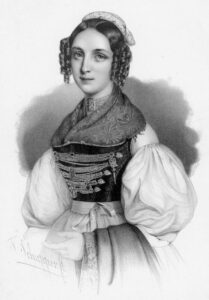
BARABARA Charivari
This exuberant jewelry is inspired by the arts and crafts heritage of artisanal societies of the Alpine region.
The BARABARA Charivari collection is hand-crafted with yarns from a heritage mill in the province of La Marche in rule France and made by a group of experienced artisan women in Rumania, applying traditional craft skills such as crochet, knitting and threading.
These are precious pieces of adornment, using almost extinct handcraft and refined heritage yarns which embody luxuriousness whilst accentuating the wearer’s personal style. We hope they will be treasured for a life-time.
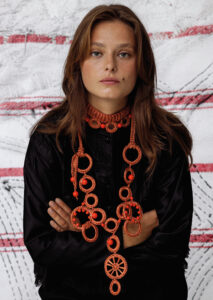



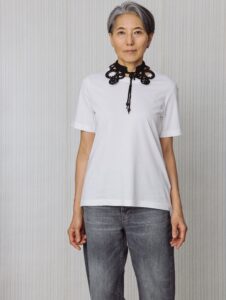
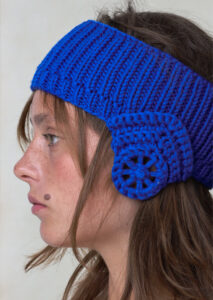
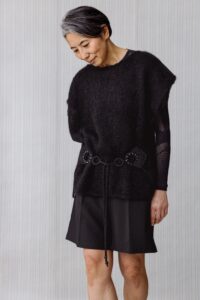
In 1789 the new ideals of the French Revolution – freedom, equality and fraternity – provoked a change of style replacing pompous luxury with simpler and uncluttered aesthetics. The Escarpin is a delicately crafted boot, built on a flat sole, the upper made from leather or fabric reaching above the ankle and closing on the side held by woven straps. For the first time, the Escarpin represented a fashion item worn by all folk regardless of their social status, sported across the entire Alpine Region and beyond.
Our boots are designed as a hybrid between a 18th century Escarpin and a 1970s Mohamed Ali boxing boot.

1850s Escarpin boots/ Victoria & Albert Museum/ London

Mohamed Ali boxing boot 1968

Women wearing Escarpin boots, Philibert Louis Debucourt, Vent derrière, 1812, The Clark Art Institute, USA
The BARABARA Escarpin
At BARABARA we love this optimistic and ‘border crossing’ concept and have developed a contemporary and non seasonal ankle boot for women of all ages and backgrounds. The BARABARA Escarpin is an alternative suggestion to the classic trainer or sneaker, which we all wear so excessively every day. The trainer is always comfortable to wear and an effortless choice to make – but we are tired of it!
With the signature BARABARA Escarpin, you will enjoy all the benefits of a classic sport shoe, but with a graceful looking and considered design.
Our shoes are made in the Marche region of Italy, by a small family business run by two sisters. The company has been making shoes for 30 years and manufactures small batches of unique shoes made of finest quality materials with rare levels of craftsmanship and care. Please find all details of our sustainable materials used on the associated product page.
A pot holder is traditionally a square of hand crochet piece of cloth that is designed to enable you to touch hot pot handles, and casserole dishes when cooking.
In the 20th century, the making of pot holders was often the first handicraft lesson in an elementary school for girls. Traditionally pot holders were made by daughters as a popular Mother's Day gift.
At BARABARA we choose this domestic hand crochet item, because for us it stands for the love and labour of generations of women who applied their joy of making and use of vibrant colour to a useful domestic tool, which is almost forgotten today. But these ladies, who went to school in the 1950s and 60s, are today's keepers of traditional crafts such crochet, knitting and embroidery. We want to pay homage to these women, who are our mothers, grandmothers or great-grandmothers today.

Perchtenlaufen is a folk custom found in the Isartal/ Bavaria region of central Europe. Occurring on set occasions, the ceremony involves two groups of locals fighting against one another using wooden canes and sticks. Both groups are masked, one as 'beautiful' and the other as 'ugly' Perchte. The Dirndl costume‘s corset top is the reference for our knitted pot holder vest.

Pot Holders Magazine (1943)
The BARABARA Pot holder Hat and Vest
The hats are constructed following the shape of a helmet, keeping your ears cosy and warm and the vests are a simplified knitted take on a traditional Bavarian Dirndl top.
Our knitwear is produced by MyOma.de, a social enterprise set up to support the older generation who are skilled at knitting and crochet, creating friendships and a source of income through a shared love of craft. Demographics show that there will be more and more older people in Germany in the future, who will need social and financial support. At BARABARA we believe that our business can make an important contribution to a sustainable integration of funds and social needs. Some of our knitters like to meet regularly to chat, others just like to knit as a creative outlet, and to earn some money with their hobby.
Such projects can only survive in the long term if our community understands the true cost – and value – of “social” products. This is why we are transparent in our pricing structure.
We are using 100 % Merino wool extrafine, mulesing free, sourced in Australia and made in Italy.
We are aiming to source recycled and local wool manufactures for the coming seasons.
At the end of World War II in 1945, Germany was split into four administrative sectors by the allied forces of France, Great Britain, Soviet Union and the United States. The state of Bavaria turned into the American occupation zone, where young US soldiers looked after the reconstruction of a new political and administrative system through the process of demilitarisation, denazification, democratization and decentralisation.
An influx of American culture and art brought about by these soldiers captivated the imagination of young Germans who were longing for a liberal and democratic way of life. American youth culture, music, film, fashion and art became sign posts for a better future promising political renewal, freedom and self expression.
Under these influences Bavaria became the cradle of new German Cinema of the 1960s and 70s.

In the 1950s and 60s every high school girl wanted to wear her boyfriend's varsity jacket.

1950s "The Dragetts and Skinners", Life Magazine, Photographer Francis Miller

1950s "The Dragetts and Skinners", Life Magazine, Photographer Francis Miller
The BARABARA Varsity Jacket
We selected the American Varsity jacket, which appeared in films by Wim Wenders, Werner Herzog and Rainer Werner Fassbinder. Becoming a global symbol for youth, camaraderie and cooperation, we are using this iconic garment as a canvas to appliqué traditional Alpine motifs as an expression of audacious optimism.
We produce this hand made jacket in our studio in Munich, made to order in limited numbers. The jackets feature embroidery, appliqué, crochet, and require complex assembly. We prefer to keep the production all in one place to keep carbon footprint and additional shipping costs to a minimum.



